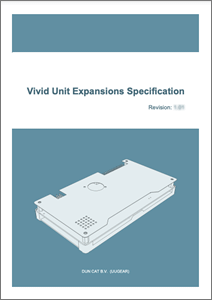expansion-addon-board-development: Difference between revisions
| (One intermediate revision by the same user not shown) | |||
| Line 26: | Line 26: | ||
However, if you have a clear idea of the specific functionality you need now and prefer a more streamlined, low-profile setup, the Vivid Unit Extender is an ideal choice. With essential features already built into the Extender (such as cooling, power protection, and an RTC backup battery), this method minimizes the effort required to create a fully functional and compact device without the need for additional layers. | However, if you have a clear idea of the specific functionality you need now and prefer a more streamlined, low-profile setup, the Vivid Unit Extender is an ideal choice. With essential features already built into the Extender (such as cooling, power protection, and an RTC backup battery), this method minimizes the effort required to create a fully functional and compact device without the need for additional layers. | ||
[[File:Vivid Unit Expansions Specification Cover.png|thumb]] | |||
=== Vivid Unit Expansions Specification === | === Vivid Unit Expansions Specification === | ||
| Line 31: | Line 32: | ||
[https://www.vividunit.com/download/files/VividUnit_Expansions_Specification.pdf Vivid Unit Expansions Specification] | [https://www.vividunit.com/download/files/VividUnit_Expansions_Specification.pdf Vivid Unit Expansions Specification] | ||
Latest revision as of 11:54, 11 November 2024
There are two different expansion methods for Vivid Unit.
Stackable expansion using the 40-pin connector
The Vivid Unit features a Raspberry Pi-compatible 40-pin GPIO header, allowing you to stack one or more expansion boards on top of it.
This expansion method offers almost limitless flexibility, enabling you to combine multiple expansion boards to create a device tailored to your specific needs.

However, a potential drawback is that the final device may become quite thick due to the height of the stacking headers. Additionally, the stacking headers occupy a significant area near the edge, which may complicate or even prevent certain applications.
Expansion through the Vivid Unit Extender
The Vivid Unit Extender is a base expansion board designed to be mounted on the back of the Vivid Unit. It routes all 28 GPIOs from the GPIO header and several signal lines (including USB 2.0, ADC, Vol+, Vol-, Power Key etc.) from the Vivid Unit to its mini PCIe connector, allowing you to connect an additional expansion board to implement the desired functionality.
One of the standout features of the Vivid Unit Extender is that it comes with commonly required functionalities already built in, such as active and passive cooling, under-voltage and over-voltage protection, an RTC backup battery, and a watchdog timer. This allows the expansion board connected to the mini PCIe connector to focus solely on its specific functionality.
All GPIO resources and signal lines are accessible to the expansion board, resulting in a relatively low-profile final device (Vivid Unit + Vivid Unit Extender + expansion board).
However, a limitation of this setup is that you can only attach one expansion board to the Vivid Unit Extender.
Which method should you choose?
Each expansion method offers distinct advantages, so the choice depends on your specific project requirements.
If your project involves cumulative expansion—where you plan to stack multiple boards to add diverse functionalities—the stackable expansion using the 40-pin connector is likely the better option. This approach offers greater flexibility and allows you to customize and expand the system over time as your needs evolve.
However, if you have a clear idea of the specific functionality you need now and prefer a more streamlined, low-profile setup, the Vivid Unit Extender is an ideal choice. With essential features already built into the Extender (such as cooling, power protection, and an RTC backup battery), this method minimizes the effort required to create a fully functional and compact device without the need for additional layers.

Vivid Unit Expansions Specification
If you are going to develop an expansion board for Vivid Unit, we recommend to follow this specification:

